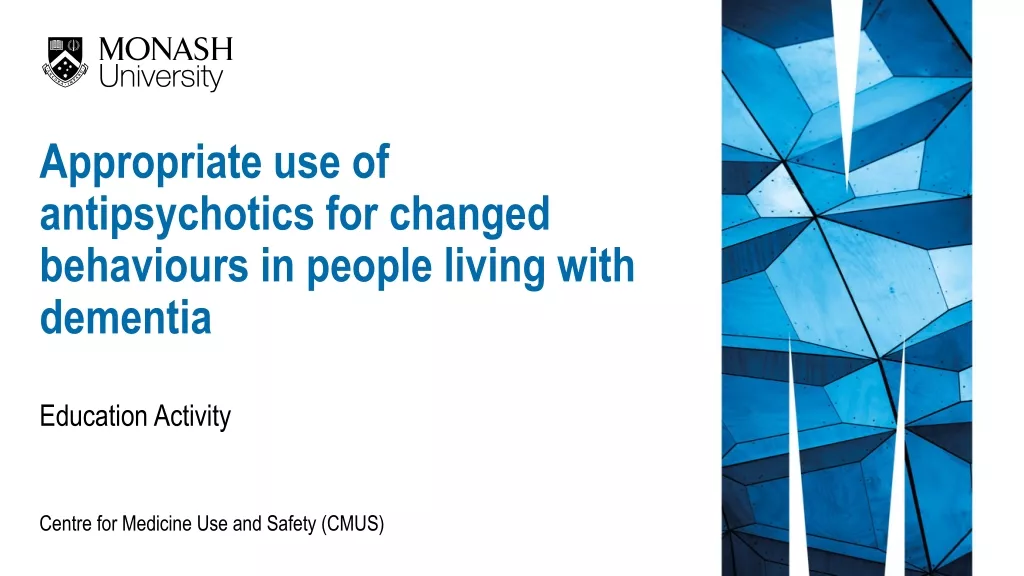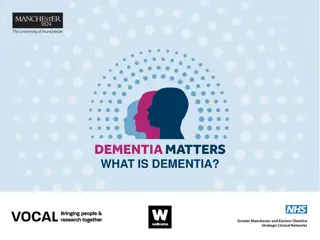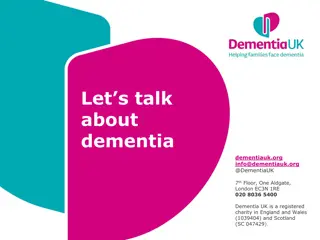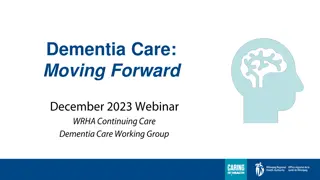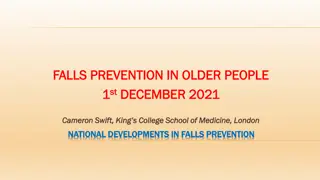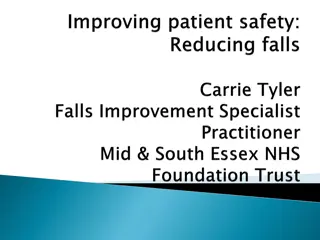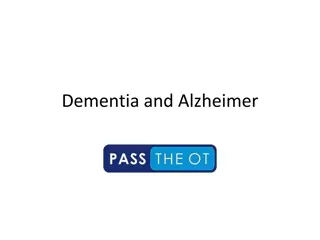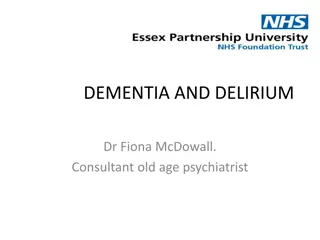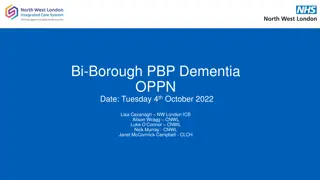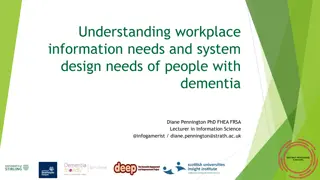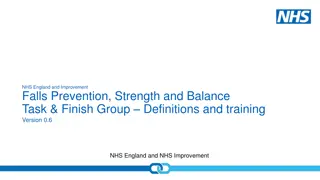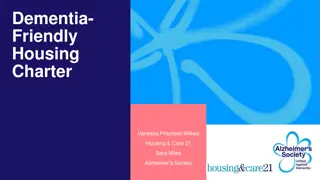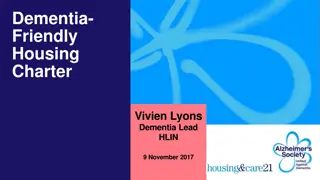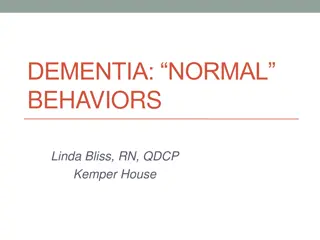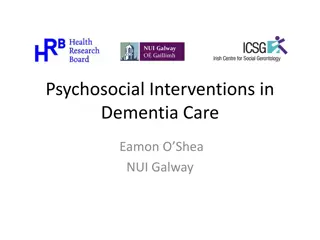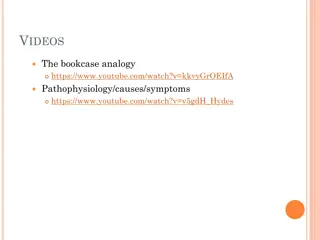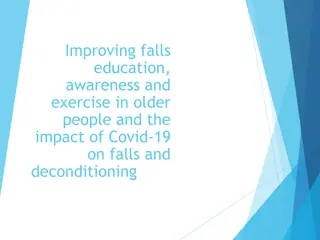Falls and Dementia: Understanding Risks
People with dementia face a higher risk of falls due to various cognitive impairments, leading to serious injuries. Alzheimer's Disease, a common form of dementia, can impact mobility, spatial awareness, and daily activities, increasing the likelihood of falls and associated risks.
Download Presentation

Please find below an Image/Link to download the presentation.
The content on the website is provided AS IS for your information and personal use only. It may not be sold, licensed, or shared on other websites without obtaining consent from the author.If you encounter any issues during the download, it is possible that the publisher has removed the file from their server.
You are allowed to download the files provided on this website for personal or commercial use, subject to the condition that they are used lawfully. All files are the property of their respective owners.
The content on the website is provided AS IS for your information and personal use only. It may not be sold, licensed, or shared on other websites without obtaining consent from the author.
E N D
Presentation Transcript
Dementia & Falls in Care Homes Falls Awareness Week 2024
Better understanding of different types of dementia and their presentations Explore the links between dementia and falls Consider person centred approach to falls prevention for this cohort of residents Content Opportunity to share best practice
People with dementia are four to five times more likely to fall than older people who do not have cognitive impairment. For those who fall, the risk of sustaining a fracture is three times higher than for cognitively well people. Falls and Dementia Also, those who fall are five times more likely to be hospitalized or live in a long-term care setting than older adults with dementia who do not fall. People with Parkinson s disease, vascular and Lewy body dementia are more prone to mobility disturbances. (Fiona Shaw, 2003)
Falls and dementia People with a cognitive impairment like dementia are at greater risk of falling and sustaining a serious injury. This is linked to some of the symptoms of dementia, such as difficulties with: Judgment and insight Sensory perception such as sight, sound, touch Mobility and coordination Communicating their needs (eg difficulty explaining that they need help to get out of bed) Interpretation of their environment, causing illusions and misperceptions e.g., depth, light intensity, colour, pattern, temperature Retention of information: loss of memory, difficulty with new learning or relearning , Initiation of tasks, leading to immobility
Alzheimer's Disease 75% of all dementia Slow onset , with a steady decline Memory loss especially with names and recent events Word finding difficulties How may Alzheimer's lead to falls ? May be unable to verbalise pain Difficulties judging how far away furniture is Example: when sitting on a chair Altered routines when getting dressed Example : Putting on shoes before trousers Forgetting Socks and Slippers As the disease progresses : Greater memory loss Impaired visuospatial skills Language difficulties Impaired functioning of daily activities Bumping into things or other people Unable to judge how close together furniture is How things look when rotated Navigation
Case Study Margaret Mo 3year history of Alzheimer's In early days of disease Mo lived at home and her daughter oved in with her to care for her Main symptoms at this time was word finding difficulties Memory loss but could still recall memories from when her children were at school and when she was working in her mum and dads' shop Falls history 2 falls occurred in the dining room when mobilising between 2 chairs getting trapped with zimmer frame. 2 falls in doorway of bedroom - lifting frame over threshold. Falls thought to be due to visual-spacial issues Plan Highlighted for discussion at home round Seen by dementia outreach and had a review of her holistic care plan Extra supervision given for Mo during lunchtime Regular chair and table with extra space created Moved to a room closer to the office doorway within eyeline sight As disease progressed Mo had difficulties at home and several falls Moved into a care home in December 2023 Remains independently mobile with zimmer frame
Vascular Dementia 20 30% of all dementias Occurs when blood supply to the brain is compromised by arterial disease Can be a sudden onset or a gradual onset Memory loss and symptoms of arterial disease Such as Diabetes , High blood pressure , Circulatory issues Depression , Anxiety Lack of interest or motivation History of smoking very common How may Vascular Dementia lead to falls? Forgetting to ask for help Example : Getting up without waiting for assistance Blurred vision , dizziness due to high bP Example : Loss of balance Depression/ Lack of interest leading to reduced movement and sitting for long periods Example : Muscle weakness knees giving way Increased fear of falling due to heightened anxiety Example : Stroke 30% of vascular dementia caused by a stroke
Case Study Jane worked her whole life as a nurse for the NHS. After retiring she continued to provide care and support to others regularly volunteering at the hospice along the road from her home. Falls History 4 falls 3 unwitnessed in other residents' rooms during day 1 witnessed right knee gave way whilst mobilising without walking frame Two years ago, Jane experienced a stroke which has led to mild weakness along her right arm and leg and vascular dementia. This led to her moving into a care home. Plan Referred to dementia outreach for support and advice. Moved room to area of home which is not as busy less buzzers going off Sensor matt in situ Signage placed on table in room reminding Jane to use her walking frame ACTION Falls checklist completed The vascular dementia meant that Jane forgets to ask for help and will often get up and forget her walking frame. Wanting to help others Jane often gets up and attempts to provide care to other residents causing numerous falls. Due ot the right sided weakness experienced by the stroke Janes right knee also gives way sometimes leading to falls.
Lewy Body Dementia Approximately 10 15% of all dementias Lewy bodies are small proteins that form in the brain Often proteins form in the cerebral cortex which is responsible for memory , speech and movement. Can present very similarly to Parkinson's disease. How may Lewy Body Dementia cause falls? Visual hallucinations or aggression causing sudden movements and a loss of balance Shuffling steps meaning a person will be prone to trips Nightmares causing broken sleep leading to disorientation and fatigue Symptoms include visual hallucinations, marked fluctuations in conscious awareness, disturbed sleep or nightmares, trembling in limbs, shuffling when walking , reduced facial expressions.
Case Study John worked for 40 years as a chemical engineer. During his working life he worked on oil rigs during the gulf war and often witnessed shell attacks and worked in war zones. Falls History 4 falls all unwitnessed Each time John found to be confused and hallucinating The falls also coincided with a previous poor night's sleep During retirement John started to lose his memory and began to experience visual hallucinations. Often these came in the form of children crying or men shouting. This caused John to become agitated sometimes and occasionally aggressive. This is often when falls occurred as John would get up and walk around trying to understand where the shouting was coming from. John also mobilises with a shuffling gait and has a tremor noted in standing . John often experienced nightmares causing broken sleep and fatigue Plan Care home team highlighted case at home round and John was referred to a community geriatrician for review. This review was able ot take place at Johns home. John was given medication to help reduce hallucinations and for him to sleep better . This reduced fatigue and meant that John was more rested and settled during the day. John has experienced no further falls
Frontotemporal Dementia How may frontotemporal dementia cause falls? Unable to understand risks to self , leading to risky behaviours. Becoming very distressed causing reduced insight into falls risks. Lack of motivation leading to long periods of time sitting or sleeping causing physical weakness. 2 10% of all dementias Affects front art of the brain which is responsible for planning , emotion, motivation and language Affects younger age group Disinhibited and socially inappropriate behaviours Impaired judgement Lack of interest and motivation
Case Study Falls History 1 fall in bedroom unwitnessed Bill reports to have been standing on his bed to reach for something on top of his wardrobes and fell sideways off the bed Bill a retired headmaster began experiencing some word finding difficulties 18 months prior to retiring. This progressed and began to include episodes of loss of memory. Bills wife also noticed some change in personality and noticed Bill would sometimes become upset at inappropriate times . To begin with Bill and his wife felt he may be depressed and coming to terms with retirement and change of routine, but as the disease progressed Bill also began to show some signs of inappropriate behaviour towards his wife and a general lack of interest in life . Plan Room moved closer to office and in line of sight of staff member overnight. Bed moved to be placed against wall reducing risk of fall from bed. Items stored on top of wardrobe moved Signage used in room to remind Bill to press call bell or ask for help. Bill was supported to live at home with a personal assistant for several years but when his wife started to struggle to support him at home he moved into a care home. Bill remains very mobile but some reduction in strength and balance. Often puts himself at risk of a fall due to having little insight into common falls risks.
Communication How the caregiver communicates with the person they are assisting is an important factor in reducing the risk of falls for people with dementia. Remember to obtain the person s attention: reduce distractions and gain eye contact Watch for non-verbal cues from the person to help understand their actions and reactions Be mindful of your approach: remain calm and watch your facial expression and gestures Give thought to how instructions are given: use short, simple sentences; suggest one step at a time; use cue; allow time; encourage the person
Visual Contrast Use obvious contrast in colour to define objects from the background. Use solid colours with no pattern to decrease confusion. Avoid black surfaces, which may be misinterpreted as being a black hole. Suggestions: Use a contrasting ,coloured rubber mat or decals on bottom of the tub. Place a contrasting, coloured towel or apply contrasting coloured tape on the edge of the tub. Use a non-slip contrasting bath matt. Install a contrasting colour toilet seat. Install darker handrails on light coloured walls. Use a contrasting colour doorsill. Apply bright, non-slip tape on the edge of each step or on the bottom and the top stair. Paint walls a light colour and baseboards a darker tone. Have darker floors and lighter coloured furniture.
Environmental Considerations Indoors Keep corridors clear of clutter Keep surfaces level, dry and non-slip Remove scatter cushions or rugs . Replace uneven, damaged flooring Avoid polishing floors. Ensure door thresholds are level with floor Clean up spills immediately. Remove light, unstable or low pieces of furniture. Keep furnishings in consistent places. Outdoors Keep pathways level, in good repair, free of clutter and clear of ice and snow. Paint step edges a contrasting colour. Enhance Accessibility Keep important items in consistent, visible, easy-to-reach places.
Bedroom Considerations Use a firm mattress. Ensure height of bed is optimised for residents needs Label cupboards with the name of the contents Keep mobility aids close by. Have important items by the bedside. Consider purchasing a fall alert device Keep room clear of clutter Ensure commodes are placed with back to a wall Consider placing bed next to a wall Consider high risk fallers and locating rooms as close to the office as possible Encourage residents to spend time in communal areas Consider how to reduce noise level Avoid sudden noises
Any actions taken to reduce falls should be clearly documented in the residents personalised falls prevention plan Consider how this plan will be updated and communicated to all staff members Ensure a detailed falls history s taken following every fall and that the history is studied for patterns and clues which could help to prevent a future fall.
Pease consider taking part in the online React To Falls Training which will provide generalized falls prevention and management training This is free and evidence based https://reactto.co.uk/react-to-falls


